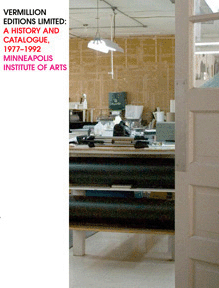Glory Days: Vermillion Editions
Minneapolis Institute of Arts and the University of Minnesota Press have published a great history and catalogue of Steven Anderson's Vermillion Editions, a fine-print studio that was a landmark entity in the heyday of Minnesota art.

This is a wonderful book for a number of reasons; it’s a fine evocation of the Twin Cities artworld of the seventies and eighties; it’s a good introduction to the phenomenon of the collaborative print studio; and mostly, it’s got hundreds of wonderful pictures.
The volume features the full collection of Vermillion Editions prints. Founded in 1977 by the master printer Steven Anderson, Vermillion Editions was a renowned print workshop housed in a warehouse-district landmark, the Wyman Building. It became a key part of the fine-print renaissance occurring at the time. Anderson collaborated with internationally known artists including Jasper Johns, Chuck Close, and Andy Warhol, and also worked with many local artists such as Tom Rose, David Rathman, and Steve Sorman.
Beyond its role as catalogue raisonne, though, the book is also a history. Kristin Makholm, now curator at the Minneapolis College of Art and Design Gallery, contributes a thorough and insightful introductory essay that paints the Minneapolis art scene of the 1970s and ‘80s with verve and detail. The many photos of artists involved with the press are fascinating and touching. Twenty-odd years on, we all look so different. The history’s account of these artists’ lives, and their bios at the end, told me much that I had never known about them. It’s a series of engaging revelations.
Dennis Michael Jon, associate curator of prints and drawings at The Minneapolis Institute of Arts and the volume’s editor, has written text that does a good job of outlining the rise of printmaking as an important sector of the art world during the twentieth century. The role of the master printer and print workshop is a fairly new thing, originating, really, with Stanley Hayter and his Atelier 17 in the 1940s. Jon lays out this genesis and makes clear how Steven Anderson and his Vermillion Editions fit into the evolving tradition.
The master printer has a unique role. He or she works with artists—many of them not printmakers at all—to create prints that are designed by the artist but produced in a collaborative process by artist and master printer together. For an artist, it’s like growing a new sense; suddenly you have more means than you did before.
It’s plain from the account in the book that Anderson was a printer of rare skill and empathic ability, who enjoyed enabling a wide range of visions. His grasp of the many print media, from lithography to screenprinting to intaglio to photo-offset, was honed in classes with Zigmunds Priede at the University of Minnesota. Priede brought him to Universal Limited Art Editions in West Islip, Long Island, where he worked on prints by artists like Robert Rauschenberg and Jim Dine. Later he worked with Styria Studio and taught print at Cooper Union and Parsons School of Design. He’d come a long way from his origins in Osseo, Minnesota.
The book also makes plain that the exacting standards and intense devotion to fresh invention that characterized Anderson’s work with artists militated against the profitability of the press. As long as Anderson had a business manager who was in sympathy with his version of the project the press did well. But when in the nineties Vermillion hooked up with corporate backers who demanded “big names” and product that could hang in a bank lobby, the project began to lose steam.
Eventually, Anderson bought the means of producing prints back from his investors, leaving the Vermillion name and inventory with them. He began to produce more prints under the name “Akasha” (Sanskrit for “ether”), but the enterprise could only continue in a reduced fashion, as funds were short.
Now we have a new print studio in town, Highpoint Center for Printmaking. Their approach is quite different from that taken by Vermillion. Rather than being only a producer of editioned prints for sale, Highpoint has created many opportunities for people to learn printmaking, to understand the various print media and their potentials. They do produce print editions, but perhaps with the glorious but difficult example of Vermillion before them, they are searching for ways to broaden their base of support.
If you have any interest in the history of the art scene here, this book would be a worthy acquision; if you love prints of all kinds, it will be an even better one. This collection gives an inkling of the sensual splendors of the Vermillion prints—if anything, larger images would have been good, but then the book would have been the size and weight of a tombstone—and provides a spur to see them in person in the many museum collections they inhabit.
The book also gives an account of a time when the big local arts institutions, the Walker Art Center in particular, were more engaged with local artists. Our cultural memory here is short; historical accounts like this of the arts of the place are few. It’s good to be reminded that things haven’t always been the same. It’s a spur to make them different again.